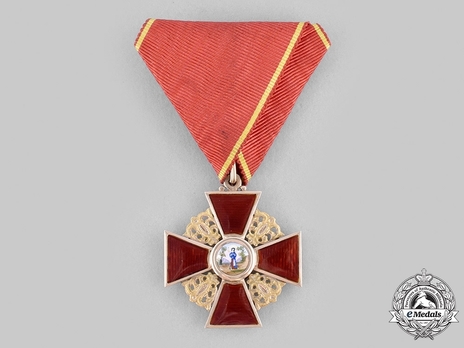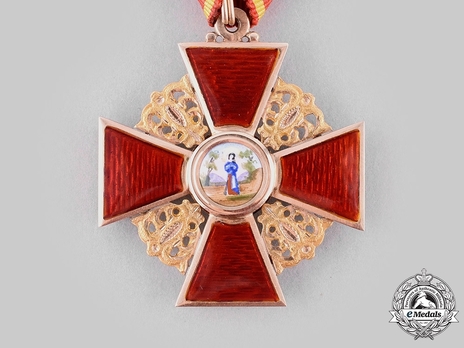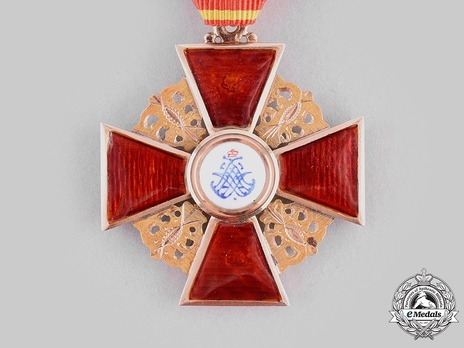Order of St. Anne, Type II, Civil Division, III Class Cross (in gold)
CATEGORY: Version
SKU: 01.RUS.0113.104.01.000
Estimated market value:



Estimated market value:
Russia, Imperial. An Order of Saint Anne, III Class in Gold
(Орден Святой Анны 3 степени). Instituted 14 February 1735 by Duke Karl Friedrich of Holstein-Gottorp. (1829-1917 issue). Constructed of Gold with multi-coloured enamels, consisting of a Cross Pattée with red enameled arms, with ornate arabesque designs joining the quadrants, the obverse with a central medallion bearing a hand-painted image of Saint Anne, the reverse with a central white enameled medallion bearing hand-painted initials “A.I.P.F.” for “ANNA IMPERATORIS PETRI FILIA” (“ANNA, EMPEROR PETER’S DAUGHTER”), the twelve o’clock arm with an integral loop and suspension ring connecting to a period original tri-fold ribbon, the reverse six o’clock arm bearing Cyrillic initials “АК” for an unidentified goldsmith, the suspension loop marked with a Gold zolotnik mark of “56” for 14 karats, measurign 34.86 mm (w) x 39.43 mm (h), weighing 10.3 grams (inclusive of ribbon), an exquisite example in extremely fine condition.
The reverse features the first letters of the Order's motto, "AMANTIBUS, JUSTITIAM, PIETATEM, FIDEM."
The Order grades which have black enamel instead of red enamel on the arms, are early versions of this Order. They are referred to as "Black Annes" and were a popular version awarded in the late 1800s.
In 1815, Emperor Alexander I added a IV Class Badge to the Order, which was strictly awarded for military merit.
From 1796 to 1828, the I and II Class Badges have versions that are decorated with brilliants. After 1828, I and II Class Badges with brilliants were only awarded to foreign dignitaries.
In 1828, a bow ribbon was added to the III Class Badge to award men for military acts of valour.
Crowns were added as a version design element to the I and II Classe awards from 1828 to 1874.
In 1844, the Order was made conferrable upon non-Christians. On these awards, the obverse image of St. Anne was replaced with an image of the Imperial Eagle.
The Military Division version of Class I and II were added in 1855, and feature the addition of intersecting swords.
Beginning in 1857, the swords intersecting the III Class military award were moved to surmount the medal.

Comments
Sign in to comment and reply.


Scroll Top